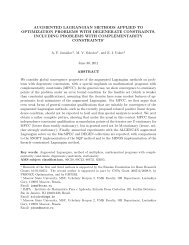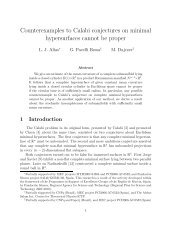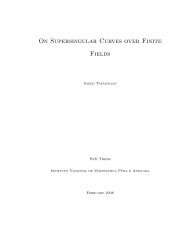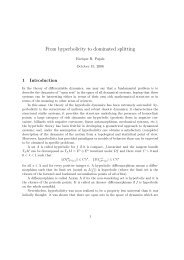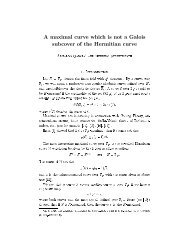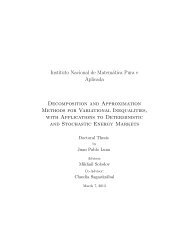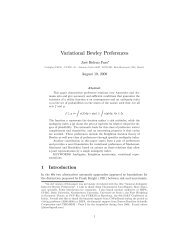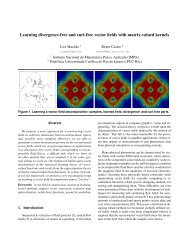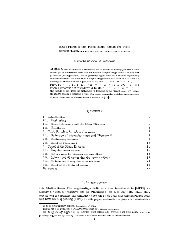Notes on Boussinesq Equation
Notes on Boussinesq Equation
Notes on Boussinesq Equation
Create successful ePaper yourself
Turn your PDF publications into a flip-book with our unique Google optimized e-Paper software.
CHAPTER 4<br />
Global Theory. Persistence<br />
4.1. Global Theory in H 1<br />
In this secti<strong>on</strong> our aim is to prove that for small data the soluti<strong>on</strong> of the IVP (1.1)<br />
in H 1 × L 2 can be extended globally (t > 0). To show this, we combine the c<strong>on</strong>servati<strong>on</strong><br />
law (4.2) (see below) and <strong>on</strong>e of the results obtained by J. B<strong>on</strong>a and R. Sachs in [6]. As<br />
we pointed out in the introducti<strong>on</strong>, Kato’s theory [22] allowed them to show the local<br />
well-posedness of the system (1.5)-(1.6) for smooth data, as we will see below.<br />
We begin by stating the following result of B<strong>on</strong>a and Sachs in [6].<br />
Denote by<br />
Y s (T ) = C ( [0, T ] : H s+2 (R) ) ∩ C 1( [0, T ] : H s (R) ) ∩ C 2 ([0, T ] : H s−2 (R)).<br />
Theorem 4.1. Let u 0 ∈ H s+2 (R) and v 0 ∈ H s+1 (R) for some s > 1/2. Then there<br />
exists a T > 0, depending <strong>on</strong>ly up<strong>on</strong> of (u 0 , v 0 ) ∈ H s+2 (R) × H s+1 (R), and a unique<br />
functi<strong>on</strong> u ∈ Y s (T ) which is soluti<strong>on</strong> of the equati<strong>on</strong> in (1.1) in the distributi<strong>on</strong>al sense <strong>on</strong><br />
R × [0, T ], and for which u(·, 0) = u 0 and u t (·, 0) = v 0 ′ . The soluti<strong>on</strong> depends c<strong>on</strong>tinuously<br />
up<strong>on</strong> the data (u 0 , v 0 ) in the sense that the mapping that associates to (u 0 , v 0 ) the soluti<strong>on</strong><br />
u is c<strong>on</strong>tinuous from H s+2 (R) × H s+1 (R) into Y s (T ). If s > 5/2 the soluti<strong>on</strong> is classical.<br />
Proof. See Corollary 2 in [6].<br />
□<br />
Now, c<strong>on</strong>sider the equati<strong>on</strong><br />
u tt − u xx + u xxxx + (|u| α−1 u) xx = 0. (4.1)<br />
Suppose that u is a soluti<strong>on</strong> of the initial-value problem (1.1) given by Theorem 4.1<br />
for s sufficiently large, thus we can proceed as follows.<br />
Apply the operarator (−∆) −1 to the equati<strong>on</strong> (4.1) and multiply by u t , then integrating<br />
respect to x, we obtain the following<br />
or<br />
1 d {<br />
‖(−∆) −1/2 u t ‖ 2 2 + ‖u‖ 2 2 + ‖u x ‖ 2 2 − 2<br />
2 dt<br />
α + 1<br />
α+1} ‖u‖α+1 = 0<br />
‖(−∆) −1/2 u t ‖ 2 2 + ‖u‖ 2 2 + ‖u x ‖ 2 2 − 2<br />
α + 1 ‖u‖α+1<br />
= K 0 (4.2)<br />
where K 0 = K 0 (f 0 , g 0 ).<br />
The relati<strong>on</strong> (4.2) is the main tool to show that ‖u(t)‖ 1,2 remains bounded <strong>on</strong> the interval<br />
[0, T ′ ) for small data, and so ‖(−∆) −1/2 u t ‖ 2 does. Hence we can apply the Theorem<br />
4.2 again to c<strong>on</strong>tinue the soluti<strong>on</strong>. So we have the following<br />
39



